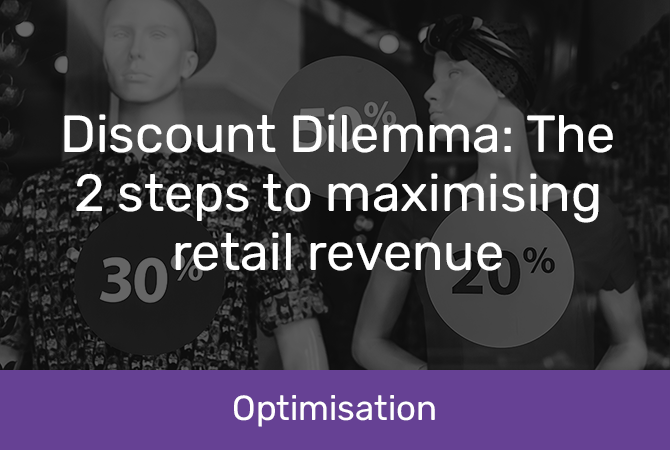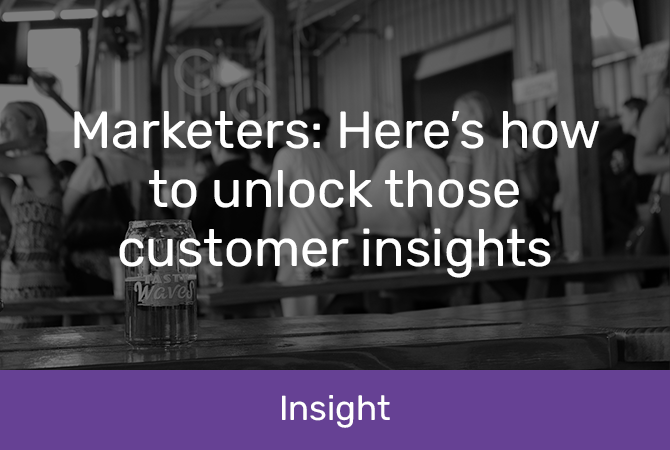
Discount Dilemma: The 2 key steps to maximising retail revenue
Buy one get one free; ‘50% off today only’; Black Friday or Boxing Day sales - anyone who has ever spent money before loves a good discount, a promotion, a mega sale. That is...everyone except the procurement or category managers of the organisation offering the discount - the behind-the-scenes masterminds who’ve meticulously negotiated with suppliers, analysed product range and determined what the ideal price for each item should be, only for that price to be (arbitrarily or not) thrown out the trolley for a lower one.
Yes, the ultimate goal of a discount is to boost sales - even if it’s just a temporary surge - and with an increase in sales should come an increase in revenue. However, in many situations the discount or promotion doesn’t actually end up having the desired effect on sales or resonate with the right customer base. Maybe the sale is ‘objectively’ successful (i.e. there is an increase in purchases of one specific item) but it hasn’t got more customers in the door or incentivised them to buy other products that aren’t discounted. This is when procurement managers need to start asking,
‘Is discounting certain products negatively affecting my business?’
Don’t get us wrong - we’re not against offering discounts. Retail and FMCG organisations typically rely on promotional campaigns and frequent discounts to keep customers from turning to their competitors, and that’s not going to change any time soon (nor should it, necessarily). What businesses do need to do, though, to truly maximise profit and the value of their promotions is take a dive into their data to figure out what specific products they should and shouldn’t be discounting. And the first step towards doing that? Better internal communications.
Step 1: Procurement and Category Management - the Dream Team
Like any good machine, a business’ various cogs need to fit together perfectly in order to function correctly and efficiently. When it comes to pricing and discounts, procurement and category management are the two most important cogs - in many organisations, unfortunately, they don’t work as closely as they should. This can lead to any number of miscommunications, with category management making the push for discounts in order to get customers through the door while procurement wonders why their previously determined prices have been disregarded.
When these two departments work together, though, they can make magic happen. As you can see from the diagram to the right, there are three levers that can be changed to impact revenue - uplift volume, base volume and margin & pricing. Various departments (including procurement and category) manage different segments of this, meaning they all need to work together to have the biggest impact on revenue. Why? Supply and demand.
- Supply: Inventory and procurement teams have an innate knowledge of products - what they’re worth, what they cost from suppliers and how much the business needs to charge for them in order to make a profit.
- Demand: Category management teams know what sales pushes need to be made to drive business forward and keep consumers happy - they know how to advertise in a way that gets customers into the store and how to discount enough to keep the customer happy but not tank the business.
Combining these knowledge bases puts organisations on the track towards drastically improving product pricing and discount strategy. Now here’s the second (and probably more important) step:
Step 2: Look to the data to maximise revenue
You might be thinking, “Alright sure - maybe my department needs to work more closely with category management going forward. But how do we actually know what products to discount?”
This is where analytics comes into the equation. Rather than choosing which products to discount based on more qualitative factors, businesses need to look at the concretely quantitative sales data. Hidden within it lie insights into each product’s price-elasticity: the relationship between price and demand. Products with high elasticity, meaning there is high demand at a low price and medium/low demand for them at a high price, are the best items to discount or have promotions for. Take, for example, these snacks from Sainsburys:
Feeling peckish?From 50p grab em while you can #N07js #saletown #salemoor @ThisIsSaleTown @salemummynet @LifeInSale pic.twitter.com/Zy6LFY07Jh
— Sale YF (@SainsburysSale) August 17, 2016
Look at spend on certain products during past promotional periods - did the price reduction also help drive sales throughout the store? Or was the boost in spend isolated to the one discounted product? Yes, you want people in the store to buy the 75% off bright pink t-shirt that you haven’t been able to get off your hands in months, but ideally you’d like that full-price flowered dress on display to catch their eye as well.
The ideal product to discount is one that encourages customers to also buy similar or accompanying items - for example, a tech store might offer a slight discount on a battery operated toy in the hopes that customers would then pay full price for a pack of batteries. Seemingly small details like this repeated in discounts and promotions on a regular basis are what really have the power to maximise revenue.
This type of analysis is relevant to both B2C and B2B businesses but is especially useful for Retail and FMCG, two industries under which a large number of Datamine’s clients fall. The following case study is a great example of the insights businesses can gain from looking at customer behaviour data during a promotion:
Case Study: Supermarket chain evaluates discount and promotion effectiveness
 Challenge
Challenge
Datamine’s client, the supplier behind a large supermarket chain, wanted to increase the chain’s revenue from deli sales and therefore needed to know what products they should and shouldn’t discount.
The project objectives were to first understand this supermarket’s position in relation to its competitors, then to identify the products where price was a key driver of volume, and finally help them set up a trial to test the effectiveness going forward.
 Solution
Solution
After establishing the supermarket’s relative position amongst competitors, Datamine analysed an entire year’s worth of the client’s customer spend data to determine which deli products had the highest price-elasticity and should therefore be promoted.
We discovered that certain brands of ham and chicken were ‘superdrivers’, meaning they accounted for a large percentage of deli sales and had high elasticity. Contrarily, the data showed that salads, such as egg or potato, sell nearly the same whether discounted or not.
 Result
Result
With the insights from Datamine, the supermarket’s procurement and marketing teams were able to take a much more targeted approach to their discounts and promotions, knowing which products would drive sales across the business and which should remain price-static going forward.
The answer to virtually every business challenge lies in the data - you just have to know what you’re looking for. Many companies have internal analytics capabilities and are able to turn to their analysts when they need to determine which products to discount. Organisations that don’t have an internal team and need help making sense of their data are welcome to get in touch with us at Datamine.
Established over two decades ago, Datamine is a leading data analytics firm that has stayed on the cutting edge of technology and data science. We are dedicated to changing the world through the application of data-driven insights, with a presence in New Zealand, Australia and the UK. For more information about revenue management, or to set up a chat with one of our business advisors, please shoot us a message using the button below.


















.jpg)







-1.jpg)






































